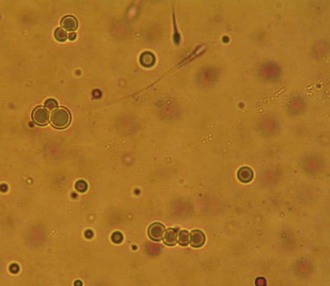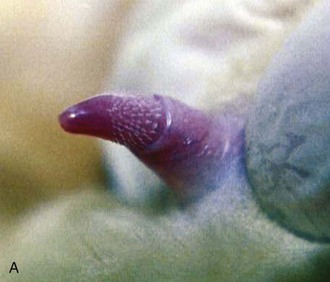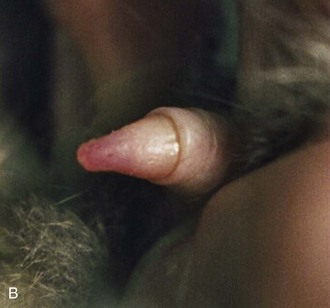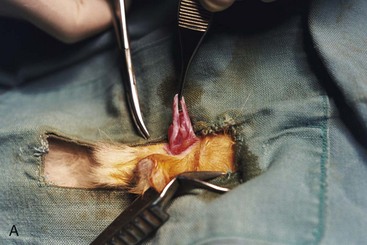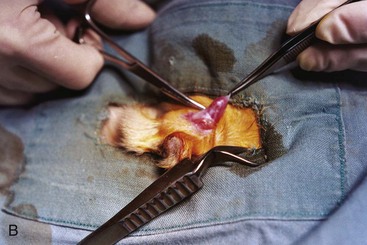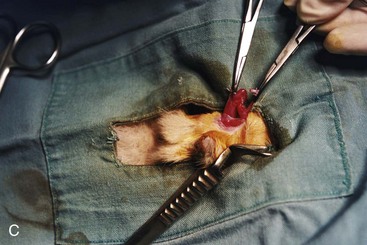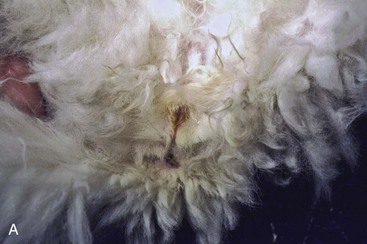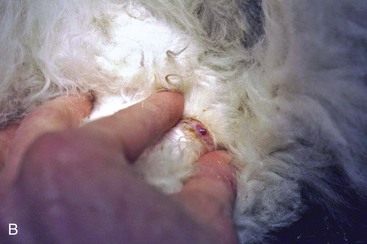CHAPTER 39 Male Reproduction
Male Anatomy
The reproductive tract of the male or tom cat consists of the penis, testes, scrotum, prostate and bulbourethral glands, and the ductus deferens (also called the vas deferens) (Figure 39-1). The fetal testes are inside the abdomen; they descend through the inguinal ring into the scrotum at birth or shortly afterward. By 6 to 8 weeks of age, testes should be palpable in the scrotum. The hair-covered scrotum is divided by a thin wall into two cavities; each cavity contains a testis, epididymis, and the end of the spermatic cord. The testes may not stay in the scrotum permanently until 4 to 6 months of age. The structure of the feline testis is similar to most domestic animals.9 There are three major cell types in the testes:
1 Interstitial (Leydig) cells: secrete testosterone in response to luteinizing hormone (LH)
2 Sertoli cells: line the seminiferous tubules and secrete estrogen and inhibin to support the developing spermatozoa in response to follicle-stimulating hormone (FSH)
3 Germ cells: spermatozoa in various stages of development present within the seminiferous tubules
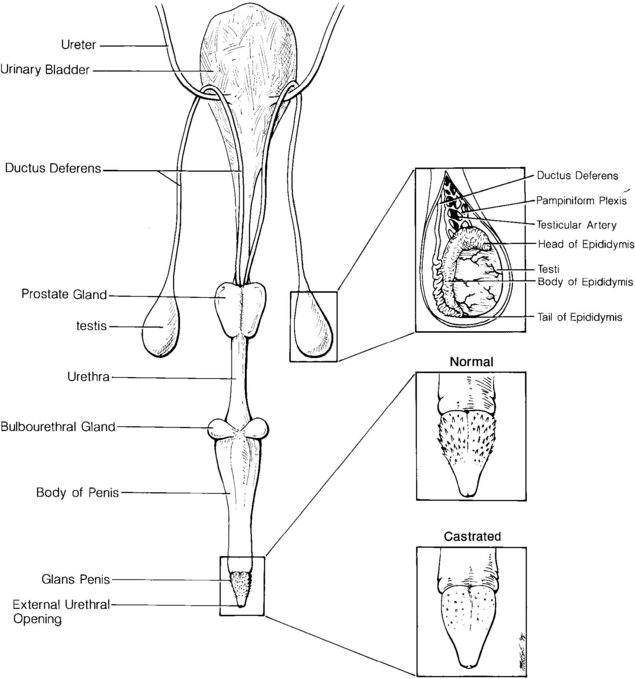
FIGURE 39-1 Anatomy of the reproductive tract of the male cat.
(From Johnston S, Root Kustritz M, Olson P: Sexual differentiation and normal anatomy of the tom cat. In Johnston S, Root Kustritz M, Olson P, editors: Canine and feline theriogenology, Philadelphia, 2001, Saunders.)
The prostate of the cat is approximately 1 cm in length and covers the urethra near the neck of the urinary bladder. The prostate is androgen-dependent and atrophies after castration. Prostatic disease is very rare in the cat, with only a few cases reports of tumors published.38,39 The bulbourethral glands are two small pea-shaped structures near the bulb of the penis. During ejaculation, spermatozoa from the epididymis are mixed with secretions from the prostate and bulbourethral glands. It is normal for a small proportion of spermatozoa to travel retrograde through the urethra into the bladder (Figure 39-2). The urethra in the male cat is very narrow and shorter than in the dog.
The penis of the cat contains a vestigial os penis (5 mm in length). When not erect, the penis is completely enclosed within the prepuce. The glans of the penis of a mature tom cat is covered with 120 to 150 penile spines that are directed caudally. The spines are testosterone-dependent and start to appear at about 12 weeks of age, are fully developed at puberty, and are absent in neutered males, disappearing by about 6 weeks after castration (Figure 39-3).
Mating Behavior
Spermatozoa are present in the testes by the age of 5 to 9 months, and full maturity of spermatogenesis occurs at 8 to 10 months of age.37 However, the actual age at which mating begins varies with physical condition, body size, and season. The onset of puberty is typically at 8 to 10 months of age and at a body weight of 2.5 kg or more. However, significant variation among breeds is seen with longhair breeds, such as the Persian, maturing more slowly than shorthair breeds, such as the Siamese. Tom cats probably have a normal breeding lifespan of 10 years or more.
After castration, mating behavior typically ceases, but may persist for years in some mature and experienced tom cats. The behavior may include mounting of other cats or kittens, the owner’s legs, or soft inanimate objects. It is important to ensure the cat is not cryptorchid (see below). A rare cause of breeding behaviors in castrated male cats is a testosterone-secreting adrenal tumor.25 The behavior may be attention seeking or because of a stimulus-poor environment. Ensuring adequate environmental enrichment and interactive time with the owner is often helpful. The behavior should not be rewarded, even inadvertently, by attempts at punishment. Interruption and distraction with another activity is likely to be more effective. Urine spraying may also persist after castration, although typically it resolves in 80% or more of cats. There is one report in the literature on the use of cyproheptadine (2 mg/cat, PO, every 12 hours) for the successful treatment of masturbation and urine spraying in a cryptorchid cat.32 For more on urine spraying, see Chapter 13.
Control of Reproduction
Surgical Castration
Castration is the most common procedure used to control fertility in male cats. The surgery is easy to perform, requires simple equipment, is effective and irreversible, and eliminates most of the undesirable traits of an intact male (e.g., aggression, roaming, urine marking).12 Cats may be castrated using either an open or closed approach. The spermatic cord may be ligated with suture material or the cord may be knotted on itself. Castration may be performed as early as 6 weeks of age (see Chapter 41). Prepuberal castration is more effective at preventing unwanted sexual behaviors than castration after sexual maturity.13 Complications associated with castration in the tom cat are few but include scrotal swelling, hemorrhage, bruising, and infection.
Vasectomy
Vasectomy involves the bilateral removal or occlusion of a portion of the ductus deferens, causing infertility by preventing ejaculation of sperm during copulation. Vasectomy does not remove or prevent undesirable sexual behaviors, because testosterone is still produced. Therefore it is infrequently used for control of reproduction in male cats. However, “teaser tom cats” (infertile males with good libido) may be used in catteries to bring queens out of heat when pregnancy is not desired. Mating with a teaser tom cat induces a pseudopregnancy in the queen and delays return to estrus. Vasectomy does not alter libido or mating ability in adult tom cats. Live sperm may be present for up to 7 weeks after surgery, however.30
Vasectomy is a relatively simple surgical procedure performed through a 1- to 2-cm incision cranial to the scrotum (Figure 39-4).14 After incision of the skin and subcutaneous tissue, the spermatic cords are identified and exteriorized from the tunica vaginalis using blunt and sharp dissection. Gentle manipulation of the testicle is helpful for identification of the spermatic cord. Once the ductus deferens is isolated, a small segment is removed and the severed ends are ligated. The subcutaneous tissue and skin are closely routinely.
Chemical Castration
An injectable sterilant, zinc gluconate neutralized by arginine (Neutersol, Addison Biological Laboratory, Fayette, Mo.), was licensed for use in puppies (3 to 10 months of age) in the United States from 2003 to 2005 and is currently not available in that country. The product was licensed in Mexico in 2008 (EsterilSol, Ark Sciences, Baltimore, Md.) for use in dogs. A product with the same active ingredient, but at a different concentration and with dimethylsulfoxide (DMSO) as a carrier, was licensed in Brazil in 2009 (Infertile; Rhobifarma, Hortolândia, Brazil), also for use in dogs. The intratesticular injection causes sclerosis of the testes and permanent sterility. In one study comparing intratesticular injection of zinc gluconate with surgical castration in dogs, the product was judged to be valuable for large-scale use, particularly in remote locations or where facilities and expertise for surgical castration are not available.21 Necrotizing injection site reactions were reported in 4 of 103 treated dogs. Neutersol is reported to be effective in cats, but has not yet been licensed in this species.19 In one study, 115 cats were injected with EsterilSol (0.3 to 0.4 mL/testis, under sedation) at 6 months of age.20 Cats were monitored for 12 months, and testicular atrophy, reduced testosterone levels, and absence of sperm were documented.
Diseases and Conditions of the Penis
Few problems affect the penis of cats; conditions found more commonly in other species, such as hypospadias and persistent penile frenulum, are rare in the cat. One case report of hypospadias in a 1-year-old Himalayan cat was associated with chronic cystitis.17 The hypospadias was surgically corrected and the cat recovered fully. A 1-year-old Persian cat presented for infertility was found to have dorsal deviation of the penis resulting from a persistent frenulum.1
A small number of cases of phimosis have been reported in the cat.4,10,22 Phimosis is due to constriction of the preputial opening that prevents protrusion of the penis. Phimosis may be congenital or acquired secondary to trauma, inflammation, or neoplasia. The most common clinical signs are stranguria, pollakiuria, and vocalizing during urination22; other clinical signs include dribbling urine, urinating outside the litter box, and inability to mate. The severity of clinical signs varies with the degree of narrowing. Diagnosis is made on physical examination. In many cases, surgical correction of the defect is necessary.
The records of 10 cats diagnosed with phimosis at Michigan State University Veterinary Teaching Hospital have been reviewed.22 The mean age at presentation was 18.6 weeks (range, 8 weeks to 2.4 years). Two of the cats had other congenital defects (cryptorchidism, penile hypoplasia). Eight of the 10 cats underwent surgical correction of the condition by a full thickness incision in the ventral aspect of the prepuce, with or without resection of a wedge of prepuce. A satisfactory outcome was achieved in seven cats, where long-term follow-up was available. Congenital phimosis has been reported in an 8-week-old domestic shorthair cat presented for hematuria, pollakiuria, and polydipsia.4 Urine culture was positive for E. coli. Surgical correction of the phimosis was accomplished by resection of a small wedge of the dorsal prepuce, and along with antibiotic treatment, led to resolution of clinical signs.
Priapism is persistent abnormal erection of the penis in the absence of sexual stimulation, and may be caused by a variety of factors, such as spinal cord injury, trauma, neoplasia, and inflammation. It is rarely reported in the cat. Priapism may be confused with paraphimosis; however, paraphimosis is associated with a narrow preputial orifice or other preputial abnormalities. Without intervention, the penis may become dry and edematous, and even necrotic. Most cases in the cat require surgical management. In a series of seven cases of priapism, six cases were in Siamese cats.11 In four of the cases, priapism developed after unsuccessful attempts at mating, despite the fact that three of the cats were castrated. Five of the cats were successfully treated with perineal urethrostomy, and histologic examination revealed thrombosis of the corpus cavernosum.
Priapism was reported in a 1.5-year-old domestic shorthair cat after routine castration.36 Two days after surgery, the cat developed pollakiuria and stranguria, as well as protrusion of the penis. The cat was successfully treated with perineal urethrostomy. Histology of the resected tissue revealed severe congestion of the corpus cavernosum, with organized thrombi and areas of necrosis. Another case of priapism was reported in a 2-year-old castrated cat with feline infectious peritonitis (FIP).31a At necropsy histologic examination of the penis revealed severe pyogranulomatous inflammation and fibrinoid necrosis of the corpus cavernosum.
Diseases and Conditions of the Testes
Orchitis is rare in the cat, although occasionally bacterial orchitis has been reported. Clinical signs include scrotal swelling, pain, and redness. Bacterial orchitis is treated with a broad-spectrum antibiotic for 2 to 3 weeks. Orchitis has also been reported as an uncommon manifestation of FIP8; one case report was a cat concurrently infected with FIV.34 Scrotal swelling may be the only sign associated with FIP in affected cats, at least initially (see Figure 33-16). The vaginal cavity around each testis is confluent with the peritoneal cavity so that fluid accumulated in the abdomen may also appear in the scrotum. Lesions in the testes are consistent with a chronic necrotic and fibrinous orchitis and fibrinous periorchitis with vasculitis.
Testicular neoplasia is uncommon in the cat. Examples of both Sertoli and interstitial cell tumors have been reported.2,26,29,38 Neoplasia of testicular origin developing after castration has been reported in five cats.6 All cases involved interstitial cell tumors within the scrotal skin or the spermatic cord. All cats were castrated at 1 year of age or younger, and the mean age at diagnosis of the neoplasia was 9.6 years. Affected cats demonstrated sexual behaviors associated with intact males, such as urine spraying and aggression. Two cats had penile spines. The study authors suggest that care be taken during castration to avoid incising the tunica albuginea to avoid transplantation of small amounts of testicular tissue, and the subsequent development of tumors.
Testicular hypoplasia and infertility may be seen in male tortoiseshell or calico cats. It has been estimated that about 1 in every 3,000 tortoiseshell or calico cats is male.15 A survey of over 4,500 male cats in the United Kingdom determined that 0.43% were tortoiseshell.18 Orange is a sex-limited coat color in cats, controlled by a single gene on the X chromosome. Black and orange color may occur together in the female, but normally would not occur together in the male. Males exhibiting black and orange coat color may have various chromosomal abnormalities, such as 39/XXY, mosaicism (two populations of cells with different genotypes from one fertilized egg), or chimerism (two or more populations of cells from the fusion of different embryos). Mosaics or chimeras are often fertile.
Both true hermaphroditism and pseudohermaphroditism are very uncommon in the cat. Many cases are unreported, because karyotyping is not widely available for cats. Affected individuals may be discovered at the time of surgical sterilization. For example, the author has examined a blue tabby intersex cat (Figure 39-5). The cat was presented as a female and was spayed without incident. Several months later, the owners complained of a strong smell to the urine, and on examination, a small penis-like structure was present in the vulva and one testis was found subcutaneously near the vulva. The cat’s specific condition was not determined, because karyotyping and gonadal histopathology was not performed.
Stay updated, free articles. Join our Telegram channel

Full access? Get Clinical Tree


